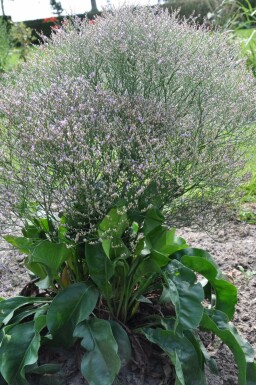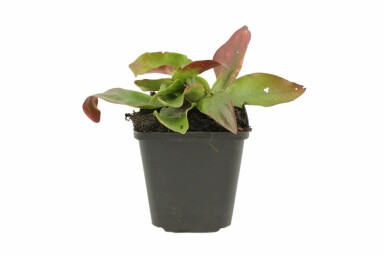

50cm



Updated on 10 September 2025
We regret to inform you that we are currently unable to ship orders to the United Kingdom. We anticipate being able to resume shipments at the beginning of 2026.
Limonium thrives in sunny borders and drought-resistant gardens, adding charm with its airy pink, white, or purple flowers. Ideal for sandy gardens, it resists sea winds and serves as an excellent cut and dried flower while attracting bees.


50cm



Limonium is a delightful addition to any garden, with its unique rosette-like leaf base and branched flower stems. Its small, papery flowers in shades of purple, pink, and white bloom from summer to autumn and emit a pleasant salty scent. Known for being drought-resistant, it thrives in sunny borders and rock gardens, making it a versatile choice for gardeners. Looking for a plant that can be used in both cut and dried flower arrangements? With its long summer bloom and salt tolerance, Limonium is perfect. Whether in a garden or a bouquet, this plant stands out. Consider exploring more about why Limonium, also referred to as sea lavender or statice, deserves a place in every border.
Limonium, also known as sea lavender, is a popular plant in gardens. It belongs to the Plumbaginaceae family and is known for its vibrant colours. This plant, often called statice, is a favourite for dried flowers due to its long-lasting nature. Limonium is widely used in borders, rock gardens, cut flower arrangements, and planters. It thrives in saline soils and offers a range of flower colours, making it a versatile choice for gardeners. Sea lavender, the common name for Limonium, is native to Southern Europe, Asia, and coastal areas. It is a salt-tolerant perennial, perfect for coastal dunes, providing nectar for bees and butterflies. This adaptability makes it suitable for various garden styles, particularly natural gardens. The name derives from the Greek "leimon," meaning meadow. Limonium holds symbolic meanings of remembrance and eternity, often found in bouquets for mourning. Its life cycle includes being a coastal perennial or annual plant, with a preference for salt and drought-tolerant conditions. It blooms for long periods and is bee-friendly, making it a valuable addition to gardens. Whether interested in buying Limonium for borders or dried bouquets, this plant is a superb choice for enhancing garden aesthetics.
Limonium, known for its distinct leaf structure, displays narrow, lanceolate, or spoon-shaped leaves. The colours range from grey-green to blue-green, offering a subtle yet attractive backdrop in any garden. These leathery leaves are well-suited to various environments due to their salt tolerance and drought resistance, thriving even in challenging conditions. During winter, Limonium retains its leaves, making it an evergreen feature in the landscape. Factors like soil conditions and location impact its hardiness, withstanding temperatures from -18°C to -12°C in USDA zones 6 to 8. This plant prefers well-drained soil and minimal wind exposure to maintain its vigour through frost periods.
Limonium's resilience extends to hot summers, thanks to its origins and structural adaptations. Its leaves have a protective layer and sometimes fine hairs that reduce water loss. A deep root system helps access moisture from soil, making it a drought-loving bloomer. In terms of safety, Limonium is non-toxic to children and pets, ensuring a secure environment in the garden. It's ideal for a family-friendly setting.
The plant's ecological value is significant, contributing to biodiversity. From July to September, Limonium’s airy flower umbels in pink, white, or purple attract pollinators, enhancing habitat balance. The flowers are suitable for cutting and drying, popular for crafts, sustaining interest in the garden even during winter. Overall, Limonium offers aesthetic and environmental benefits, making it a valuable addition for anyone looking to grow Limonium latifolium UK or explore drying flowers for crafts.
Sea lavender, known for its vibrant colours and resilience, is ideal for adding a touch of elegance to various garden styles. Here are some creative ways to include sea lavender in your garden:
Limonium is known for its papery flowers and blends beautifully with other garden plants. It works well in sunny borders and drought-resistant gardens, where it adds a long summer bloom. Pairing Limonium with grasses like Festuca creates a textural contrast that is visually appealing. This combination thrives in rock gardens, highlighting the salt-tolerant nature of Limonium. For a vibrant display, mix Limonium with Sedum and Achillea. These plants share a love for sunny positions and require low water, making them ideal companions. The bold colours of Sedum and Achillea enhance the soft hues of Limonium, providing a striking contrast throughout the seasons. Including Perovskia, also known as Russian sage, adds height and additional colour to the mix. The silver foliage of Perovskia complements the delicate flowers of Limonium, creating a harmonious look. Together, these plants form a diverse and resilient display, perfect for cut and dried flowers. Limonium's lasting blooms ensure that the garden continues to impress well into the late summer months.
Limonium thrives best in sunny locations. At least 6 hours of sunlight daily is essential for healthy growth. It is drought-tolerant and performs well in well-drained soil. This plant prefers calcareous, dry, sandy, or even salty soils, making it quite adaptable. However, it can be sensitive to strong winds. To prevent damage, consider planting it near a windbreak or using garden structures as shields. For optimal growth, a well-draining soil is crucial. Incorporate sand if needed, and ensure regular but not excessive watering. Over-watering can be detrimental, considering Limonium's preference for dryer conditions. Adding compost can enhance soil fertility and support robust flowering. The ideal pH for Limonium is neutral to slightly alkaline. Checking soil pH can help maintain an environment conducive to growth. Regular fertilisation assists in maintaining nutrient-rich conditions, encouraging blooms. Whether used as a cut flower or a dried flower favourite in borders or bouquets, Limonium is a versatile and hardy choice for the UK garden. Consider adding this sea lavender to enhance garden beauty and resilience.
Planting Limonium or sea lavender is best done in spring after the frost has subsided. Limonium in pots can be planted year-round except during frozen times. For those with a root ball, it's ideal in spring or autumn. When planting, the space between plants depends on the type, size, and speed of growth. Statice needs at least 30 cm between each plant. Always check the product page for exact details on planting distances. Proper soil preparation is vital. Dry, sandy, or stony soil suits Limonium well. Using Heijnen planting soil ensures good results. Full sun is a must; at least 6 hours a day. Avoid wet soil, as sea lavender thrives in well-draining places. When planting, water the soil well and add fertiliser to promote growth. After planting, regular watering in dry spells ensures healthy development. Sea lavender is salt-tolerant and drought-resistant, making it perfect for coastal gardens.
Limonium, also known as sea lavender, thrives in gardens as a perennial favourite for its stunning blooms from July to September. It is a salt-tolerant plant often found in coastal areas, making it perfect for a natural garden setting. Here are some essential care and maintenance tips to ensure Limonium flowers beautifully each season.
Limonium offers unique beauty in the garden with its charming and colourful blooms. Known for its papery flowers, it blossoms in shades of lilac, purple, pink, and white. Its airy structure adds elegance and provides a stunning display when planted in sunny borders or rocky gardens. The grey-green and blue-green leaves of Limonium complement its vibrant flowers, enhancing the garden's visual appeal. This plant serves as an excellent dried flower, retaining its colour and shape long after summer. Limonium is a drought-tolerant ornamental grass with a long flowering period. It attracts bees and other pollinators, enriching the garden's ecosystem. Additionally, it functions well as a cut flower, perfect for both fresh and dried arrangements. Limonium not only offers beauty but also resilience. It thrives in sandy gardens and withstands sea winds, making it ideal for coastal areas. As a salt-tolerant plant, it ensures longevity and beauty throughout the seasons. Embrace the charm of Limonium for a garden that's both visually striking and ecologically beneficial.
Limonium, commonly known as sea lavender, is a popular choice for gardeners due to its unique appearance and versatility. It thrives in UK gardens, providing beautiful blooms from July to September. Sea lavender is known for its tolerance to saline soil and a wide range of flower colours. These attributes make Limonium ideal for both garden borders and dried bouquets. Here are some favourite types of Limonium species.
These popular and widely used Limonium species are available for online purchase at Heijnen, ensuring that gardeners can easily find the perfect plant to suit their needs.
Limonium, often appreciated for its versatility and beauty, is a popular choice among gardeners. Here are some benefits and drawbacks to consider when planting this unique plant.
Advantages:
Disadvantages:
Proper soil preparation, choosing the right location, and regular care and fertilisation can reduce the risk of disease and pests. It is crucial to maintain the health of Limonium (sea lavender) plants for optimal growth and flowering.
Limonium is a wonderful choice for any garden. It thrives in sunny borders and is perfect for drought-resistant areas. Limonium can be planted in sandy gardens and withstands the sea wind, making it ideal for coastal regions. Available in a range of flower colours, it blooms from July to September, adding vibrant hues to the garden. Choosing Limonium from Heijnen ensures quality and confidence. This sea lavender is not only decorative but also excellent for cut and dried flowers. As a bee plant, it attracts pollinators, enhancing the ecosystem. With its tolerance to saline soil, Limonium is versatile and robust. For anyone in the UK looking to buy Limonium, Heijnen offers the best options. The long flowering season and resistance to harsh conditions make it a gardener’s favourite. Sea lavender's ability to brighten up any space, whether in a border or dried bouquet, is unmatched. Order Limonium (Sea Lavender) from Heijnen and enjoy drought-tolerant blooms and perfect cut or dried flowers.
We would like to provide some tips on how to plant and care for a Limonium. By following these tips, you can be sure to enjoy your Limonium for a long time.
Limonium grows best in sunny locations with well-drained soil. It prefers calcareous, dry, sandy, or salty soils and can tolerate drought due to its leathery leaves and salt tolerance. Providing at least 6 hours of sun per day ensures healthier growth and richer blooms. The ideal spot enhances its resistance and results in vibrant foliage and longevity. Limonium can be planted in sunny borders, rock gardens, or used as cut and dried flowers. It thrives in pots and planters as well. For the best results, plant in spring after the frost risk has passed. The right location is crucial for optimal growth and flowering of Limonium, ensuring a beautiful display in the garden.
Preparing the soil properly is vital when planting limonium. Start by loosening the soil to improve water drainage and mix in compost to enrich the ground. This ensures enough nutrients are available for growth. It's crucial to have the right soil preparation; only then can planting begin. Proper ground preparation allows limonium to thrive, ensuring the soil is porous and nutrient-rich. For best results, plant limonium in dry, sandy, or calcareous soil. Pot-grown plants can be planted all year round, except during frost. For sea lavender, planting is ideal in spring or autumn. After planting, water the plants until they root well in the soil. The size of the plant at planting time determines how many can be planted per square metre. Ensure the new limonium plantings receive water consistently to establish strong roots.
Limonium benefits greatly from timely fertilisation, ensuring robust growth and vibrant blooms. While it requires little fertiliser, a light application in spring can significantly enhance its vitality. This approach helps in establishing strong roots and healthy foliage, crucial for the plant's overall health. Using an organic or organo-mineral fertiliser like those from Heijnen promotes sustainable growth and rich flowering. Such fertilisers support the plant's natural resilience and improve soil quality. Fertilising sea lavender twice a year, in spring and summer, aligns with its growth cycle. For best results, adjust the amount based on the plant's size, ensuring it complements the garden's needs. As nutrients are absorbed after dissolving in water, watering is essential during dry spells to activate the fertiliser. By following these steps, Limonium will thrive in any garden setting, from borders to rock gardens.
Limonium is best pruned after it blooms to encourage more flowers in the next season. Pruning helps keep the plant healthy and promotes stronger growth. For gardens, this is especially useful as it makes Limonium more attractive. The best time to prune Limonium is late summer or early autumn, right after the flowering period has ended. Regular pruning once a year is usually enough. Sharp secateurs or a garden knife are essential tools for this task. Good tools make clean cuts, reducing damage to the plant. Keeping tools in good condition is important for effective pruning. Always ensure secateurs are sharp and clean to maintain the health of Limonium. Proper pruning enhances the plant's appearance and longevity, making it a perfect addition to any garden setting.
Limonium, known for its resilience, requires minimal watering. This plant thrives in dry, sandy soil and has low moisture needs. Newly planted limonium must be watered regularly to establish strong roots. Once established, water is only necessary during prolonged dry spells. It's better to water thoroughly when needed rather than giving a little each day. The best time to water limonium is early morning or late afternoon to minimise evaporation. Checking the soil helps determine if watering is needed. Ensure excess water can drain away, as this is vital for limonium in both ground and pots. Drip irrigation systems are effective once the plant is fully established, but additional watering is essential at the planting stage. Limonium is highly drought-resistant, making it perfect for dry borders or coastal gardens.
The Limonium is a stunning addition to any garden, known for its airy blooms in pink, white, or purple. It thrives in sandy soils and is resistant to sea winds, making it ideal for coastal gardens. This plant is also a favourite for its long flowering period and attracts bees, enhancing garden biodiversity. As a symbol of remembrance and eternity, it’s popular in dried bouquets. The Limonium, or sea lavender, is safe for children and pets, offering beauty and peace of mind.
Limonium, known for its resilience and beauty, is best propagated by seed or root cuttings. Splitting is not common for this plant. Propagation is vital as it rejuvenates limonium, promoting healthier growth. Dividing sea lavender helps maintain the plant's vigour and removes older parts. This can lead to more blooms and a thriving appearance in the garden. For those propagating, carefully take root cuttings or collect seeds and plant them in well-drained soil. This process may be done every few years. While spring and autumn are favourable seasons, autumn is often preferred for propagation. Use a sharp knife or spade to ensure clean cuts when taking cuttings. Regular maintenance encourages strong, vibrant limonium plants.
Sea lavender features rosette-like leaf bases and branched stems with papery flowers in shades of lilac, purple, pink, and white. It blooms from summer to autumn, ideal for sunny borders or rock gardens. As a nectar source for bees and butterflies, it thrives in coastal areas with salty conditions. Enjoy its long-lasting beauty as a dried flower. Order Limonium (Sea Lavender) from Heijnen and enjoy its versatility today.
